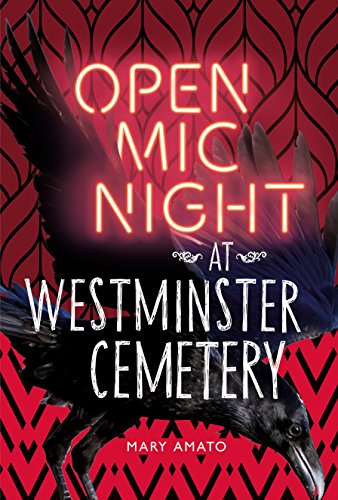“Open Mic Night at Westminster Cemetery” by Mary Amato


I have an interest in old cemeteries – I love to take photographs of the old headstones, crypts, and monuments. And I used to drive almost past the Westminster Cemetery, the final resting place of Edgar Allan Poe, on my daily commute to and from work near downtown Baltimore, Maryland. So, naturally, I was drawn to Mary Amato’s novel, Open Mic Night at Westminster Cemetery.
The book tells the story of Lacy Brink, a 16-year-old “modern”. Lacy died unexpectedly and wakes up to find that she has been buried in Westminster Cemetery. Lacy is the first person to have been buried in the cemetery since 1913.While alive, Lacy would often go to the cemetery to be alone and work on her poetry.
Lacy finds that the cemetery is ruled with an iron fist by old Mrs. Steele. Mrs. Steele does not like Lacy and her modern look, her modern language, and her modern ways, and her son’s apparent infatuation with Lacy. Three violations of the arcane rules of the cemetery will result in Lacy’s “suppression” – having to remain underground at all times for eternity.
Amato is best known as an YA author. The themes in Open Mic Night should be familiar to YA readers. The conflict that drives the plot is the perennial struggle of youth to overcome the unreasonable rules and restrictions of the old fogeys. The is also the struggles of Lacy and her sister Olivia, who feels responsible for Lacy’s death, to come to grips and cope with Lacy’s tragic, early death. There is Sam, Mrs. Steele’s son, a want-to-be poet who died in the Civil War at the age of 17, trying to overcome his paralyzing lack of self confidence and shyness that stems from his mother’s overbearing control. And, towards the end, there is even the admission on the part of Mrs. Steele that she has long struggled with how to balance the need to maintain decorum in the cemetery without being too mean and overbearing.Open Mic Night is a fun, quick read. It is written as a play and is relatively short for a novel. But it is packed with plenty of conflict and interesting character development. Yet, I, as an old fart, with a not-so-old heart, I hope, can still appreciate the trials and development of the characters. The writing is smooth and the dialog flows well, even if it may not be entirely “period accurate” to the time that some of the characters. Author’s notes and asides deviate from the script format, but provide nice breaks and humor.